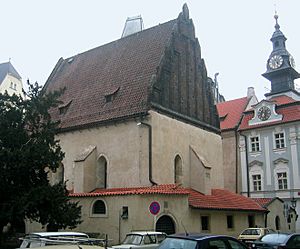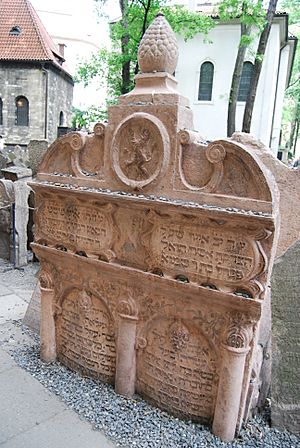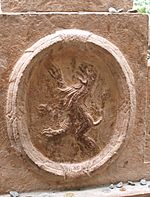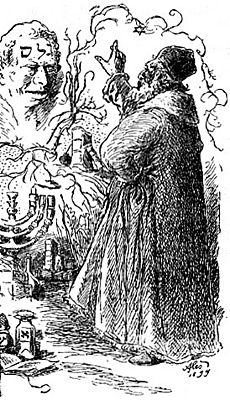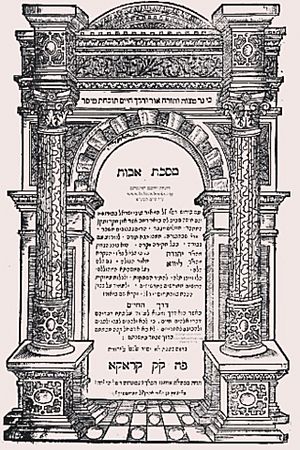Judah Loew ben Bezalel facts for kids
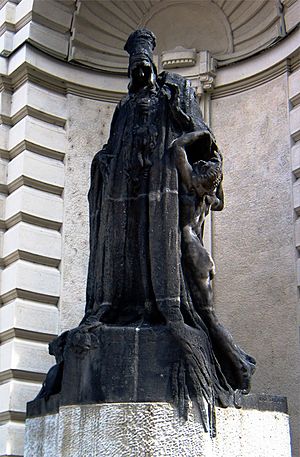
Ladislav Šaloun's statue of Loew at the New City Hall of Prague in the Czech Republic
|
|
| Religion | Judaism |
|---|---|
Quick facts for kids Personal |
|
| Born | between 1512 and 1526 Poznań, Poland |
| Died | 17 September 1609 Prague, Bohemia, HRE |
| Signature |  |
| Buried | Old Jewish Cemetery, Prague |
Judah Loew ben Bezalel (Hebrew: יהודה ליווא בן בצלאל; between 1512 and 1526 – 17 September 1609), also known as Rabbi Loew (alt. Löw, Loewe, Löwe or Levai), the Maharal of Prague (Hebrew: מהר״ל מפראג), or simply the Maharal (the Hebrew acronym of "Moreinu ha-Rav Loew", 'Our Teacher, Rabbi Loew'), was an important Talmudic scholar, Jewish mystic, and philosopher who, for most of his life, served as a leading rabbi in the cities of Mikulov in Moravia and Prague in Bohemia.
Within the world of Torah and Talmudic scholarship, Loew is known for his works on Jewish philosophy and Jewish mysticism and his work Gur Aryeh al HaTorah, a supercommentary on Rashi's Torah commentary. He is also the subject of a 19th-century legend that he created the Golem of Prague, an animate being fashioned from clay.
Contents
Early life
Loew was probably born in Poznań, Poland,—though Perels lists the birth town mistakenly as Worms in the Holy Roman Empire—to Rabbi Bezalel (Loew), whose family originated from the Rhenish town of Worms. Perels claimed that his grandfather Chajim of Worms was the grandson of Judah Leib the Elder and thus a claimant to the Davidic line, through Sherira Gaon. However, modern scholars such as Otto Muneles have challenged this. Loew's birth year is uncertain, with different sources listing 1512, 1520 and 1526. His uncle Jakob ben Chajim was Reichsrabbiner ("Rabbi of the Empire") of the Holy Roman Empire, and his older brother Chaim of Friedberg was a famous rabbinical scholar and Rabbi of Worms and Friedberg. There is no documented evidence of his having received formal religious education, leading scholars to conclude that he was an extremely gifted autodidact.
His name
His name "Löw" or "Loew", derived from the German Löwe, "lion" (cf. the Yiddish Leib of the same origin), is a kinnui or substitute name for the Hebrew Judah or Yehuda, as this name—originally of the tribe of Judah—is traditionally associated with a lion. In the Book of Genesis, the patriarch Jacob refers to his son Judah as a Gur Aryeh, a "Young Lion" (Genesis 49:9) when blessing him. In Jewish naming tradition the Hebrew name and the substitute name are often combined as a pair, as in this case. The Loew's classic work on the Rashi commentary of the Torah is called the Gur Aryeh al HaTorah in Hebrew, meaning "Young Lion [commenting] upon the Torah".
Loew's tomb in Prague is decorated with a heraldic shield with a lion with two intertwined tails (queue fourchee), alluding both to his first name and to Bohemia, the arms of which has a two-tailed lion.
Career
He accepted a rabbinical position in 1553 as Landesrabbiner of Moravia at Mikulov (Nikolsburg), directing community affairs but also determining which tractate of the Talmud was to be studied in the communities in that province. He also revised the community statutes on the election and taxation process. Although he retired from Moravia in 1588 at age 68, the communities still considered him an authority long after that.
One of his activities in Moravia was the rallying against slanderous slurs on legitimacy (Nadler) that were spread in the community against certain families and could ruin the finding of a marriage partner for the children of those families. This phenomenon even affected his own family. He used one of the two yearly grand sermons (between Rosh Hashanah and Yom Kippur 1583) to denounce the phenomenon.
He moved back to Prague in 1588, where he again accepted a rabbinical position, replacing the retired Isaac Hayoth. He immediately reiterated his views on Nadler. On 23 February 1592, he had an audience with Emperor Rudolf II, which he attended together with his brother Sinai and his son-in-law Isaac Cohen; Prince Bertier was present with the emperor. The conversation seems to have been related to Kabbalah (Jewish mysticism, Hebrew: קַבָּלָה) a subject which held much fascination for the emperor.
In 1592, Loew moved to Poznań, where he had been elected as Chief Rabbi of Poland. In Poznań he composed Netivoth Olam and part of Derech Chaim (see below).
Loew's brother, Chaim ben Betzalel, authored a legal work Vikuach Mayim Chaim which challenged the rulings of Crakow legalist, Moshe Isserles.
Influence
Disciples
It is unknown how many Talmudic rabbinical scholars Loew taught in Moravia, but the main disciples from the Prague period include Rabbis Yom-Tov Lipmann Heller and David Gans. The former promoted his teacher's program of regular Mishnah study by the masses, and composed his Tosefoth Yom Tov (a Mishnah commentary incorporated into almost all published editions of the Mishnah over the past few hundred years) with this goal in mind. David Ganz died young, but produced the work Tzemach David, a work of Jewish and general history, as well as writing on astronomy; both Loew and Ganz were in contact with Tycho Brahe, the famous astronomer.
Jewish philosophy
Loew's numerous philosophical works have become cornerstones of Jewish thought; and, in the words of a modern writer, Loew "prevented the Balkanization of Jewish thought".
Loew was not a champion of the open study of Kabbalah as such, and none of his works are in any way openly devoted to it. Instead, what they attempt to do is to make the ideas of the Kabbalah (which he held to be the most deeply true of all the Torah) accessible to the average educated reader, by presenting them in a rigorously philosophical form, couched in terms that are accessible to the public. According to R. Loew, only the greatest of Torah scholars are able to perceive the full intent of the Kabbalistic works in their complex entirety. Therefore, although kabbalistic doctrine permeates his writings, it is always presented in a rational and philosophic form. As Lurianic Kabbalah had not by that time reached Europe, his main kabbalistic influences appear to have been the Zohar, Sefer Yetzirah, and traditions of the Chassidei Ashkenaz.
Faced with the Aristotelian interpretation of Talmudic Aggadot by Azariah dei Rossi, he was indignant at what he termed the trivialization of the Sages' deep wisdom. In his work Be'er ha-Golah he vigorously disputes all of dei Rossi's theses, sternly upholding the subtly allegorical nature of Aggadah and demonstrating its independence from (and superiority to) the superficial observations of natural science. At the same time he was entirely in favor of scientific research, so long as the researcher did not use his observations as permission to contradict the final authority of divine revelation. His constant thesis is that the Talmudic, Midrashic, and Aggadic teachings refer always to matters far beyond the competence of natural science. See Aggadah#Interpretation of the Aggadah § Notes.
His works inspired the Polish branch of Hasidism, as well as a more recent wave of Torah scholars originating from Lithuania and Latvia, most markedly Rabbi Eliyahu Eliezer Dessler (1892–1953) as well as Rabbi Abraham Isaac Kook (1864–1935).
A more recent authority who had roots in both traditions was Rabbi Isaac Hutner (1906–1980). Rabbi Hutner succinctly defined the ethos of Loew's teachings as being Nistar BeLashon Nigleh, meaning (in Hebrew): "The Hidden in the language of the Revealed". That is, Loew couched kabbalistic ideas in non-kabbalistic language. As a mark of his devotion to the ways of Loew, Rabbi Hutner bestowed the name of Loew's key work the Gur Aryeh upon a branch of the yeshiva he headed when he established its kollel (a yeshiva for post-graduate Talmud scholars) which then became a division of the Yeshiva Rabbi Chaim Berlin in New York during the 1950s, known as Kollel Gur Aryeh. Both of these institutions, and the graduates they produce, continue to emphasize the intellectual teachings of Loew. Rabbi Hutner in turn also maintained that Rabbi Samson Raphael Hirsch (1808–1888) (19th-century Germany) must also have been influenced by Loew's ideas basing his seemingly rationalistic Weltanschauung on the more abstract and abstruse teachings of the unfathomable Jewish Kabbalah.
Personal life
His family consisted of his wife, Pearl, six daughters, and a son, Bezalel, who became a Rabbi in Kolín, but died early in 1600. He was independently wealthy, probably as a result of his father's successful business enterprises.
Death
Towards the end of his life he moved back to Prague, where he died in 1609. Loew is buried at the Old Jewish Cemetery, Prague in Josefov, where his grave and intact tombstone can still be visited.
Descendants
Among his many descendants were Yair Chaim Bachrach, Rabbi of Worms and author of Chavos Yair, and Schneur Zalman of Liadi, founder of Chabad Hasidism. Through this paternal line, Loew is the ancestor of many prominent Jews, including Menachem Mendel Schneerson, seventh Rebbe of Lubavitch, and violinist Yehudi Menuhin. Loew is also a (paternal) ancestor of Rebbe Nachman of Breslov (who was also a maternal great-grandson of the Baal Shem Tov, founder of Hasidic Judaism), and an ancestor of aerodynamic theoretician Theodore von Kármán. His descendants' surnames include Braude, Leib, Lev, Lew, Loewy, Loeb, Lowy, Lowi, Low-Beer, Loew, Oppenheimer, Pfaelzer, Schneerson, Lowenstein, Gurary and Keim.
In Sherry Turkle's book, The Second Self, there is a footnote which states that several well known AI researchers grew up with a family tradition that they are descendants of Loew, including Gerald Sussman, Marvin Minsky and Joel Moses. Moses reported that a number of other scientists considered themselves descendants as well, including John von Neumann and Norbert Wiener.
Legend of the golem
Loew is the subject of the legend about the creation of a golem, a creature made out of clay to defend the Jews of the Prague Ghetto from antisemitic attacks, particularly the blood libel. He is said to have used mystical powers based on the esoteric knowledge of how God created Adam. The general view of historians and critics is that the legend is a German literary invention of the early 19th century. The earliest known source for the story thus far is the 1834 book Der Jüdische Gil Blas by Friedrich Korn. It has been repeated and adapted many times since.
Works
He began publishing his books at a very late age. In 1578, at the age of 66, he published his first book, Gur Aryeh ("Young Lion", Prague 1578) - an supercommentary in five volumes for Rashi's commentary on the Torah, which goes well beyond that, and four years later he published his book Gevuroth HaShem ("God's Might[y Acts]", Cracow 1582) anonymously.
- Gur Aryeh ("Young Lion", Prague 1578), a supercommentary on Rashi's Pentateuch commentary
- Gevuroth Hashem ("God's Mighty Acts", Cracow 1582), for the holiday of Passover - On the Exodus and the Miracles.
- Derech Chaim ("Way of Life", Cracow 1589), a commentary on the Mishnah tractate Avoth
- Derashot ("Sermons", Prague 1589 and 1593), collected edition by Haim Pardes, Tel Aviv 1996.
- Netivoth Olam ("Pathways of the World", Prague 1595-1596), a work of ethics
- Be'er ha-Golah ("The Well of Exile", Prague 1598), an explanatory work on the Talmudic and Midrashic Aggadah, mainly responding to interpretations by the Italian scholar Azariah dei Rossi (Azariah min ha-Adumim)
- Netzach Yisrael ("The Eternity of Israel", Prague 1599; Netzach "eternity", has the same root as the word for victory), on Tisha B'Av (an annual day of mourning about the destruction of the Temples and the Jewish exile) and the final deliverance
- Tif'ereth Yisrael ("The Glory of Israel", Venice 1599), philosophical exposition on the Torah, intended for the holiday of Shavuot
- Or Chadash ("A New Light", Prague 1600), on Purim
- Ner Mitzvah ("The Candle of the Commandment", Prague 1600), on Hanukkah
- Chiddushei Aggadot ("Novellae on the Aggada", the narrative portions of the Talmud), discovered in the 20th century
- Divrei Negidim ("Words of Rectors"), a commentary on the Seder of Pesach, published by a descendant
- Chiddushim al Ha-Shas, a commentary on Talmud, recently published for the first time from a manuscript by Machon Yerushalayim on Bava Metzia; Shabbos, and Eruvin; others may be forthcoming.
- Various other works, such as his responsa and works on the Jewish Sabbath and the holidays of Sukkot, Rosh Hashana and Yom Kippur, have not been preserved.
His works on the holidays bear titles that were inspired by the Biblical verse in I Chronicles 29:11: "Yours, O Lord, are the greatness, and the might, and the glory, and the victory, and the majesty, for all that is in the heavens and on the earth [is Yours]; Yours is the kingdom and [You are He] Who is exalted over everything as the Leader." The book of "greatness" (gedula) on the Sabbath was not preserved, but the book of "power" (gevurah) is Gevurath Hashem, the book of glory (tif'arah) is Tif'ereth Yisrael, and the book of "eternity" or "victory" (netzach) is Netzach Yisrael.
Commemoration
In April 1997, Czech Republic and Israel jointly issued a set of stamps, one of which featured the tombstone of Loew. In May 2009, the Czech Post issued a stamp commemorating the 400th anniversary of Loew's death. In June 2009 the Czech Mint issued a commemorative coin marking the same milestone.
See also
 In Spanish: Rabbi Judah Loew para niños
In Spanish: Rabbi Judah Loew para niños
- Kerem Maharal, a moshav in northern Israel named in his honour
- André Neher
- Statue of Judah Loew ben Bezalel, Prague


